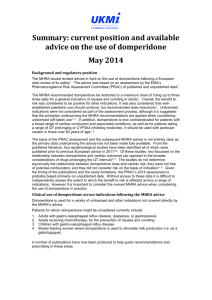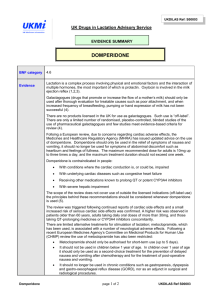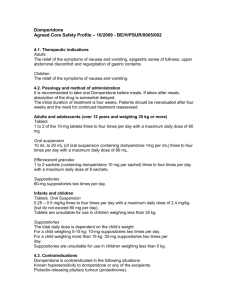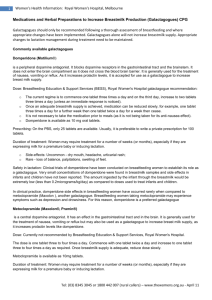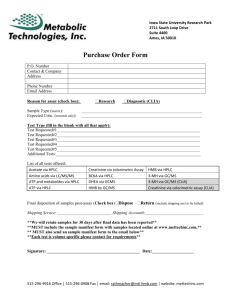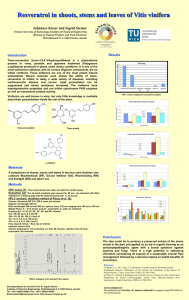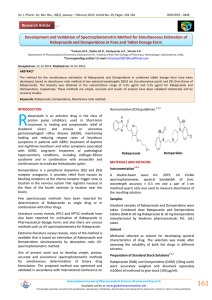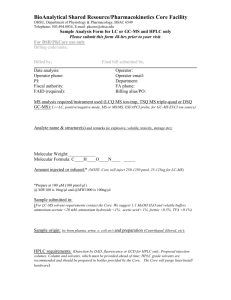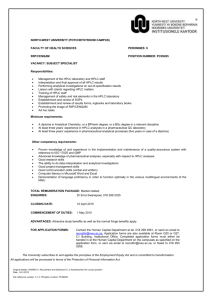Title: - A VALIDATED STABILITY INDICATING METHOD OF ASSAY
advertisement
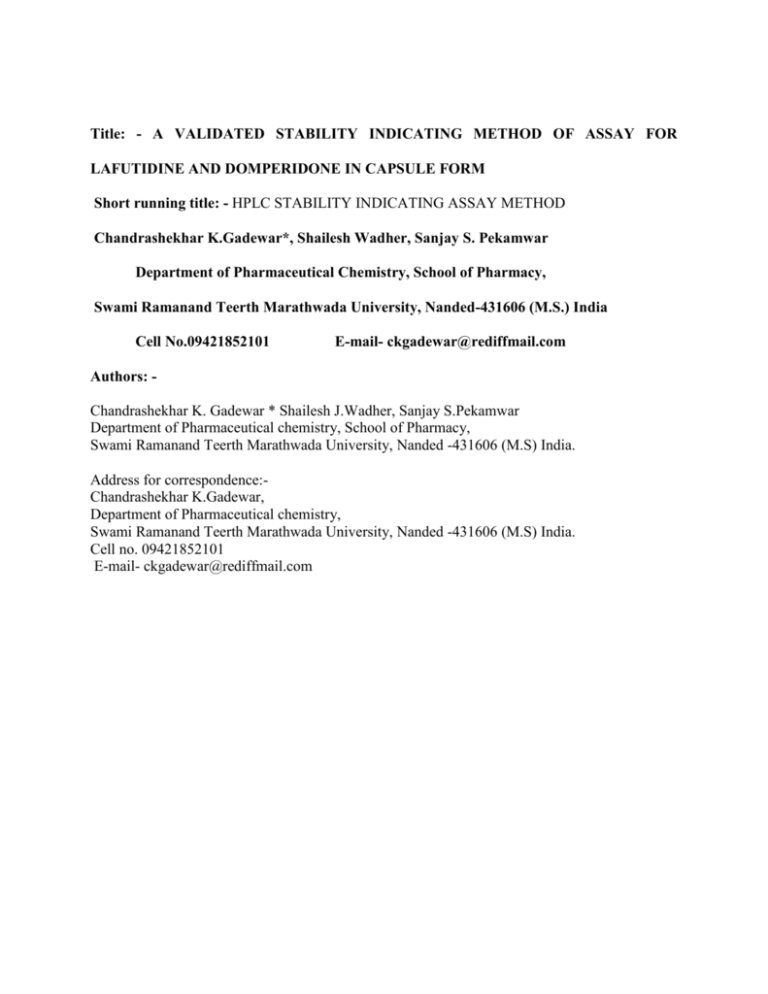
Title: - A VALIDATED STABILITY INDICATING METHOD OF ASSAY FOR
LAFUTIDINE AND DOMPERIDONE IN CAPSULE FORM
Short running title: - HPLC STABILITY INDICATING ASSAY METHOD
Chandrashekhar K.Gadewar*, Shailesh Wadher, Sanjay S. Pekamwar
Department of Pharmaceutical Chemistry, School of Pharmacy,
Swami Ramanand Teerth Marathwada University, Nanded-431606 (M.S.) India
Cell No.09421852101
E-mail- ckgadewar@rediffmail.com
Authors: Chandrashekhar K. Gadewar * Shailesh J.Wadher, Sanjay S.Pekamwar
Department of Pharmaceutical chemistry, School of Pharmacy,
Swami Ramanand Teerth Marathwada University, Nanded -431606 (M.S) India.
Address for correspondence:Chandrashekhar K.Gadewar,
Department of Pharmaceutical chemistry,
Swami Ramanand Teerth Marathwada University, Nanded -431606 (M.S) India.
Cell no. 09421852101
E-mail- ckgadewar@rediffmail.com
Abstract:A simple, sensitive, precise and specific high performance liquid chromatography method was
developed and validated for the determination of Lafutidine and Domperidone in Lafutidine and
Domperidone sustained release capsule. The separation was carried out by using a mobile phase
consisting Acetonitrile: pH 6.5 phosphate buffer in ratio of 30:70. The column used was Xterra
250mm X 4.6mm, 5μ with flow rate 1 ml/min using UV detection at 276 nm. The retention time
of Lafutidine and Domperidone were found to be 7.0 and 15.5 min respectively. And forced
degradation study of Lafutidine and Domperidone in its capsule form was conducted under
condition of hydrolysis,Oxidation, thermal and photolysis Lafutidine and Domperidone was
found stable in basic buffer as well as in acidic buffer. The detector respond of Lafutidine and
Domperidone is directly proportional to concentration ranging from 30% to 150% of test
concentration i.e. 14.74mcg/mL to 27.37mcg/mL for Lafutidine and 41.79 mcg/ml to
77.60mcg/mL for Domperidone, result of analysis were validated statistically and by recovery
studies (mean recovery = 99.94). The result of study showed that the proposed method is simple,
rapid, precise and accurate, which is useful for the routine determination of Lafutidine and
Domperidone in pharmaceutical dosage form.
Keywords:-Lafutidine, Domperidone, Method development, Validation, Forced degradation
INTRODUCTION:
Lafutidine[fig.1] is 2-[(2-furylmethyl) sulfinyl]-N-((2Z) -4-{[4-(piperidin-1-ylmethyl) pyridin2-yl]oxy}but-2-en-1-yl)acetamide. It is a Gastroprotective and Antiulcer drug, which selectively
block H2 receptors. Physical properties are white crystalline powder, soluble in methanol and
freely soluble in Glacial acetic acid, stable under ordinary condition.
Domperidone[1][fig.1a] is 5-chloro-1-(1-[3-(2-oxo-2,3-dihydro-1Hbenzo[d]imidazol1yl)propyl
piperidin-4-yl)-1H-benzo[d]imidazol2(3H)-one. It is an Antiemetic drug, which selectively block
CTZ receptors. Physical properties are white crystalline powder, soluble in 0.1N HCl.
This paper describes validated HPLC method for estimation of Lafutidine and Domperidone,
a mobile phase consisting Acetonitrile: pH 6.5 phosphate buffer in ratio of 30:70. The column
used was Xterra 250mm X 4.6mm, 5µ with flow rate 1 ml/min using UV detection at 276 nm.
MATERIALS AND METHOD:
Equipments:
HPLC equipped with pump, injector and PDA detector Waters 2695, 2996, HPLC equipped
with pump, injector and UV detector, Waters 2695, 2487, HPLC equipped with pump, injector
and UV detector, Agilent 1200 series, Balance-Sartorius, Mettler Toledo, Photo stability
chamber-Newtronic, Oven- Techno Instrument
Materials:
Lafutidine standard (Alkem), Capsules were procured from FR&D department. Disodium
hydrogen phosphate dehydrate (Merck), Acetonitril(Merck), Orthophosphoric acid(Merck),
MilliQ water, Hydrochloric acid(Merck),Sodium hydroxide(Merck),Column Xterra
250mmX4.6mm,5µ.
Preparation of 0.01 M Disodium hydrogen phosphate dihydrate buffer pH 6.5:[2]
Dissolve 4.45 gm Disodium hydrogen phosphate dihydrate in to 1000 ml water, mix and adjust
pH 6.5 with orthophosphoric acid, Filter through 0.45µ nylon filter, mix and degas.
Preparation of mobile phase:
Mix above Buffer and Acetonitrile in the ratio of 70:30, mixed and degassed.
Use suitable High Performance Liquid Chromatography equipped with following:
Column: Xterra 250mm X 4.6mm, 5µ. Flow rate: 1.0 ml/min
Wavelength: 276nm
Injection volume: 1µl
Column oven temperature: 30ºC
Sample compartment temp: 25ºC
Run time: 30 minutes
Preparation of standard Solution:
Weigh accurately about 20 mg of Lafutidine working standard and 60mg of Domperidone
working standard transfer into a 100ml volumetric flask, add 70ml of methanol, sonicate to
dissolve and make up the volume with methanol. Further dilute 5ml to 50ml with mobile phase.
Preparation of Sample solution:
Weigh and transfer the content of 20 capsules and powder the content. Weigh accurately quantity
of powder containing the equivalent of about 30 mg of Domperidone into a 100 ml volumetric
flask. Add 70ml of methanol sonicate for 15 minutes with intermittent shaking and make up the
volume with methanol. Filter through 0.45μ Nylon membrane filter or 0.45μ PVDF membrane
filter. Further dilute 5ml to 25 ml with mobile phase.
Procedure:
Wash the column and equilibrate with mobile phase. Separately inject equal volumes (20µl) of
the Standard preparation (Five replicate injections) and assay preparation (Duplicate injection)
into the chromatograph [3]. The System suitability parameters should be met. From the peak
responses, calculate the content of Lafutidine and Domperidone in the sample. [3]
The retention time of Lafutidine peak and Domperidone peak is about 7.0 minutes and 14.5
minutes respectively.[fig.4]
Evaluation of system suitability: [Table 1]
From standard solution:
1) The % RSD for the peak areas of Lafutidine and Domperidone from five replicate injections
should not be more than 2.0.
2) The tailing factor for Lafutidine and Domperidone should be not more than 2.0.
VALIDATION METHOD [3,4]:
Linearity:
The linearity of Lafutidine and Domperidone was performed using standard solution in the range
of 14.74 mcg/mL to 27.37 mcg/mL of Lafu and 41.79mcg/mL to 77.60 mcg/mL of Dom (about
30% - 150% of test concentration). A graph was plotted with concentration (in mcg/ml) on x-axis
and peak areas of Lafutidine and Domperidone on Y-axis. Slope, y-intercept, correlation
coefficient (r-value) and residual sum of squares (RSS) were determined fig.2 and 3. The results
are tabulated in table 2 and 3.
Accuracy:
Placebo spiked with the known amount of 100% and 130% of test concentration as Lafutidine
and Domperidone. The amount of Lafutidine and Domperidone was quantified as per the test
method. The percentage recovery was calculated from the amount found and actual amount
added. The results are tabulated in table 4 and 5.
Robustness:
Robustness of the method was verified by deliberately varying the following instrumental
conditions:By changing the flow rate by 10%, By changing the temperature by 5°C, By
changing the wavelength by 2nm, By changing the organic content by 2% (absolute), By
changing the pH of buffer in mobile phase by 0.1 units. The results are tabulated in table 6&7.
FORCED DEGRADATION:
Forced degradation study was carried out by treating the sample under the following conditions.
[5, 6,8,9] (Table 8 & 9) (Fig 5-10)
a) Degradation by hydrochloric acid (Acid treated sample)
Sample was treated with 5ml of 1N Hydrochloric acid and kept on water bath at 60°C for 20
minutes. Treated sample solution was analyzed as per the test method. [fig.6]
b) Degradation by sodium hydroxide (Base treated sample)
Sample was treated with 5ml of 1N Sodium hydroxide and kept on water bath at 60°c for 15
minutes. Treated sample solution was analyzed as per the test method [fig.7].
c) Degradation by hydrogen peroxide (Peroxide treated sample)
Sample was treated with 5ml of 50% Hydrogen peroxide solution and kept on water bath at
60°c for 5 minutes. Treated sample solution was analyzed as per the test method.[fig.8]
d) Degradation by thermal (Heat treated sample)
Sample was kept in oven at 105°C for about 30 hrs. Treated sample was analyzed as per the
test method. [fig.9]
e) Degradation by UV –Visible light (UV-visible treated sample)[10]
Sample was exposed to UV light of about 200 watt hours/square meter and to visible light for
about 1.2 million lux hours in photo stability chamber. Treated sample was analyzed as per the
test method. [fig10]
RESULT AND DISCUSSION:
In order to develop an effective method for the analysis of the drugs in pharmaceutical
formulations, preliminary tests [4] were performed in order to select adequate and optimum
conditions. Parameters such as detection of wavelength, ideal mobile phase and their
proportions, optimum pH and concentration of standard solution were studied. The method
developed with Column Xterra 250mm X 4.6mm, 5µ using flow rate: 1.0 ml/min, wavelength
276 nm at room temperature. The linearity of Lafutidine and domperidone was performed using
standard solution in the range of 14.74 mcg/mL to 27.37 mcg/mL and 41.79 mcg/mL to77.60
mcg/mL respectively (about 30% - 160% of test concentration).
CONCLUSION:
The HPLC method for the assay of Lafutidine and Domperidone in Lafutidine (10mg IR) and
Domperidone (10mg IR + 20mg SR) capsule was found to be simple, precise, accurate, and rapid
and validated. The mobile phase is simple to prepare and economical. The sample recoveries in
formulation were in good agreement with their label claim. Hence it can be easily and
conveniently adopted for routine analysis of Lafutidine and Domperidone in capsule.
ACKNOWLEDGEMENT:
The authors are thankful to Director and Dean of school of pharmacy, SRTM University, Nanded
for providing all required facilities for above research work.
Conflicts of interest: None
References:
[1] USP NF, The official Compendia of Standards, 2009, 1, 734.
[2] Beckett A.S., Stanlake J.B., Practical Pharmaceutical chemistry, 4th edition , CBS Publisher
and Distributor, New Delhi, 1997, 2.
[3] Sethi P.D., HPLC, Quantitative analysis of pharmaceutical formulation, CBS Publisher and
Distributor, New Delhi, 2001.
[4] Snyder L.R., Kirkland J.J., Practical HPLC method development, Wiley inter science
publication, Networks 1997, 686-772.
[5] Singh S.S and Bakshi, M. Development of validated stability indicating assay methodscritical review. J. Pharm. Biom. Anal 2002; 28: 1011-1040.
[6] ICH, Stability testing of new drugs substances and products, Q1A (R2).International
conference on Harmonization, Geneva.2003
[7] Sarah K. Branch. Guidelines from the International Conference
On Harmonisation (ICH) review. J.Pharm.Biom.Anal. 2005; 38:798-805.
[8] D.D.Hong, M.Shah Development and validation of HPLC stability indicating assays, In:
Drug stability:Principles and Practices, J.T.Carstensen, C.T.Rhodes,Marcel Dekker, New
York.2002; 329-384.
[9] Barron, M.D.,implementing successfully Stability Testing operations, Pharm. Tech., 2003;
2:14-21
[10] An-Bang Wu, et.al Stability-Indicating High-Performance Liquid Chromatographic Assay
Method and Photo stability of Carprofen.,J.Chrom.Sci.2001;39:9-11
[11] Della Grace,et al A validated stability indicating HPLC method for determination of
Valsartan in tablet dosage form, J.Applied Pharm Sci.2011; 01(4): 97-99.
[12] Mohammadi A.,et.al A stability-indicating high performance liquid chromatographic assay
for determination of orlistat in capsules. J.of Chromat. A 2006, 1116:153-157
[13] Singh S.,et.al, Stress degradation studies on ezetimibe and development of a validated
stability-indicating HPLC assay. J. Pharm. Biom. Anal.2006:41:1037-1040.
[14] Klick, S.et.al, toward a generic approach for stress testing of drug substance and drug
products. Pharm. Tech., 2005; 2: 48-66.
[15] Acharya, M.M., Pharmaceuticals stability Testing and studies, an overview, The Eastern
Pharmacist, 1999; 31-36.
URLs:
http://www.sigmaaldrich.com/catalog/ProductDetail.do?D7=0&N5=SEARCH_CONCA
T_PNO|BRAND_KEY&N4=D122|SIGMA&N25=0&QS=ON&F=SPEC
http://www.sinopharmchem.com/products2/118288-08-7.html
http://www.acgpubs.org/JCM/2010/Volume%204/Issue%201/2_JCM-1003-15.pdf
